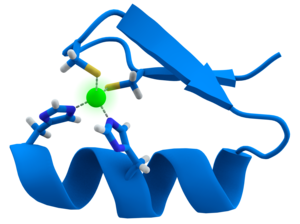Zinc finger
Zinc finger nucleases (or ZFN) was a tool used to target genes and change DNA. It was one of three methods of changing the genome with engineered nucleases.[1] It is now superseded.[2]

Zinc fingers are man-made molecules made of a protein and zinc. Each binds to a specific DNA. Zinc-finger nucleases (ZFNs) are enzymes got by fusing a zinc finger to a DNA cleavage enzyme called a Fokl. So the ZFN binds onto a specific DNA sequence, then snips it in two places. Regular cell enzymes stick the ends together, minus the bit snipped out (DNA repair).
Each ZFN is made to use on a single gene which is called a “target gene” or “target DNA”. They can be designed to work on specific parts of genes to create a desired change. The two types of DNA changes are mutations such as deletions and insertions. Genetics research looks at the mutated subjects (animals, plants, bacteria) to find out what the particular gene does.
Zinc finger structure
change'Zinc finger' is the name of many protein structures.[3] The zinc atom binds the proteins and makes them more stable. ZFNs bind to DNA base pairs. One zinc finger can bind about 3 base pairs by itself.
ZFN function
changeZinc finger nucleases are made with 3-6 zinc fingers. ZFNs have two important domains: a DNA-binding domain and a DNA-cleavage domain.[4] The DNA-cleavage domain uses an enzyme called Fokl that breaks DNA.
ZFN’s can only change DNA sequences they are designed for. The DNA-binding domain binds to a specific DNA sequence. Two ZFN’s designed for the same DNA sequence are needed change one gene. The DNA-binding domains bind to both strands on the DNA double helix. DNA-cleaving domains break the DNA strand and cut the gene base pairs out. Cells fix broken DNA strands on their own using DNA repair. Deletion mutations result from missing base pairs after DNA repair.
The length of target gene sequence can also be specified. A minimum of 9 base pairs can be changed using 3 zinc fingers. This is useful for removing and inserting very short DNA sequences and determining their effect on the target gene. Also large sequences can be changed using more than one ZFN.
Use of ZFNs
changeZFNs were used to discover gene functions in many genetics studies.[5] ZFNs could be used to change DNA on any species. Another feature of ZFNs is that they can be used in vivo (in living organisms). They were used on model organisms: plants,[6] insects,[7] and fish.[8]
Problems using ZFNs
changeThe biggest issue with ZFNs was accidentally altering genes besides the target gene. A ZFN must be made to find the right base pairs on the target gene. These base pairs are chosen so only the target gene will have them. DNA-cleavage domains work on any DNA sequence so binding to a wrong gene sequence will change it instead. ZFNs that knock out base pairs for more than one gene are not considered accurate.
Superseded
changeZFNs have now been superseded by techniques called CRISPR. Crisper techniques are easier to use, less costly and have a much wider range of uses.[2]
References
change- ↑ Nucleases are enzymes which chop up nucleic acids like DNA.
- ↑ 2.0 2.1 Doudna J. & Sternberg S. 2017. A crack in creation: the new power to control evolution. Bodley Head, London, p111. ISBN 978-1-847-92382-0
- ↑ Klug A, Rhodes D (1987). "Zinc fingers: a novel protein fold for nucleic acid recognition". Cold Spring Harb. Symp. Quant. Biol. 52: 473–82. doi:10.1101/sqb.1987.052.01.054. PMID 3135979.
- ↑ Zinc finger nucleases: custom-designed molecular scissors for genome engineering of plant and mammalian cells.
- ↑ Klug, Aaron (2010). "The discovery of zinc fingers and their applications in gene regulation and genome manipulation". Annual Review of Biochemistry. 79: 213–231. doi:10.1146/annurev-biochem-010909-095056. PMID 20192761. Archived from the original on 2019-07-10. Retrieved 2012-11-08.
- ↑ High-frequency modification of plant genes using engineered zinc-finger nucleases
- ↑ Targeted chromosomal cleavage and mutagenesis in Drosophila using Zinc-finger nucleases
- ↑ Emerging gene knockout technology in zebrafish: zinc-finger nucleases